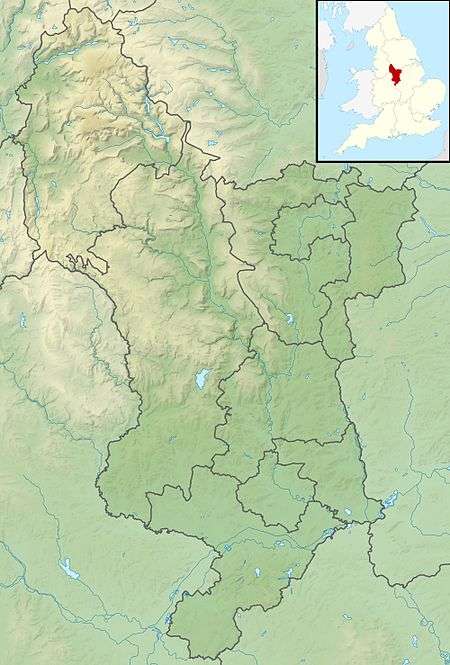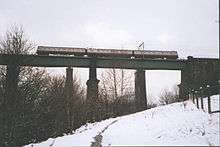Dinting Viaduct
| Dinting Viaduct | |
|---|---|
|
The central section as viewed from the A57; 2008 | |
| Coordinates | 53°26′51″N 1°58′21″W / 53.447554°N 1.972529°WCoordinates: 53°26′51″N 1°58′21″W / 53.447554°N 1.972529°W |
| Carries | Glossop Line |
| Crosses | Dinting Vale; Glossop Brook; A57 |
| Locale | Glossop, Derbyshire, England |
| Other name(s) | Dinting Arches |
| Maintained by | Network Rail |
| Characteristics | |
| Total length | 1,200 feet (370 m) |
| Height | 119 feet (36 m) |
| History | |
| Construction begin | 5 March 1842 |
| Opened | 8 August 1844 |
 Dinting Viaduct Location in Derbyshire | |
Dinting Viaduct (also known as Dinting Arches) is a 19th-century railway viaduct in Glossopdale in Derbyshire, England, that carries the Glossop Line over a valley at the village of Dinting. It crosses the Glossop Brook and the A57 road between Manchester and Sheffield.
First opened in 1844 as part of the original Woodhead Line, the viaduct has been modified a number of times, most notably by the addition of seven brick strengthening piers in 1918–20. The viaduct comprises three sections: starting from the south end, there is a series of seven stone arches, each 50 feet (15 m) wide. The central section consists of five openings (later divided by strengthening piers). A further four stone arches take the railway to the northerly junction with the Hadfield branch and into Dinting station.[1] It is of similar design to the shorter Broadbottom Viaduct[1] about 1.5 miles (2.4 km) west down the same line, which crosses the River Etherow at Broadbottom.
History
The modern-day Glossop branch line originally opened as the Woodhead Line in December 1845, which linked Sheffield to Manchester. It was closed in 1981 leaving only the Manchester to Glossop/Hadfield section still in operation.[2] The viaduct over the River Etherow at Broadbottom had been completed in December 1842, extending train services to Glossop, with the contract for the Dinting viaduct being let in June that year. In August 1844 the bridge was opened allowing trains to reach Hadfield from Manchester. The original construction of the two bridges used laminated timber arches.[2]
By 1856, the level of rail traffic and the weight of the trains had increased so much that the existing timber viaducts were considered inadequate, and in 1859 wrought-iron girders were installed to replace the timber arches. By early the following year, this work had been completed on both bridges. Over the next 60 years, the level of traffic increased yet further, partly due to the heightened use of coal trains, so that the 1859 works became insufficient to deal with the weight. Seven brick strengthening piers were inserted during the years 1918–20,[1] and again at Broadbottom, leaving the irregular pattern of piers seen today.[2]
Major work was carried out in the 1950s in preparation for the electrification of the line.[3] The first electric train travelled over in 1954.[4][2]
In 2012–13, an extensive refurbishment was undertaken by Network Rail, the viaduct's maintainer, including strengthening the girders, installing new bearings and repairs to the steel, brickwork and masonry. It was also repainted olive green.[5] The scheme cost £6.4 million.[6][7]
Deaths of 1855
On 19 September 1855, a train was halted on the viaduct by signals to let another train pass, causing some of the passengers to think they had arrived at Hadfield station. Three left the train, stepping onto the low parapet of the viaduct, and fell to their deaths. Two were killed instantly, and the third died within an hour.[5][7][8][9]
Design
Dinting is much the larger of two similar viaducts on the line (the other being the Broadbottom Viaduct), both of which are significant for their height. It has four main spans, each of four ribs, flanked by eleven brick-built, semi-circular approach arches, each with a fifty-foot (fifteen-metre) span—four at one end and seven at the other. Seven intermediate supporting piers were added in 1919, constructed of blue brick and irregularly spaced to avoid the road and river beneath, thus resulting in the loss of the viaduct's symmetry.[10] This alteration was criticised by the architectural writer Nikolaus Pevsner.[11]
Gallery
|
See also
| Wikimedia Commons has media related to Dinting viaduct. |
References
- 1 2 3 Johnson, E. M. (1996). Scenes from the Past 29: Woodhead Part One. Foxline. p. 105. ISBN 1870119436.
- 1 2 3 4 Smith, Martin. "Line History". High Peak and Hope Valley Community Rail Partnership. Retrieved 4 October 2014.
- ↑ "Dinting Arches". Glossop Tours. Retrieved 4 October 2014.
- ↑ "Woodhead Railway". Top Forge. Retrieved 4 October 2014.
- 1 2 "Dinting Arches Gets a Facelift" (PDF). Glossop Life: 26–27. May 2013. Retrieved 4 October 2014.
- ↑ "Praise for £6.4m plan to strengthen Dinting viaduct". Manchester Evening News. 8 March 2012. Retrieved 4 October 2014.
- 1 2 "Glossop's Dinting Arches Undergoing Refurbishment". Glossop People. Retrieved 4 October 2014.
- ↑ "The Provinces". The Spectator. 22 September 1855. Retrieved 4 October 2014.
- ↑ "The Railways in Glossop". Glossop Heritage. Retrieved 4 October 2014.
- ↑ Biddle, Gordon. Britain's Historic Railway Buildings: A Gazetteer of Structures (Second ed.). Hersham, Surrey: Ian Allan Publishing. pp. 292–293. ISBN 9780711034914.
- ↑ Pevsner, Nikolaus (1978). The Buildings of England: Derbyshire. revised Elizabeth Williamson. Penguin Books. p. 219. ISBN 0-14-071008-6. "Arches spoilt by reinforcement."
